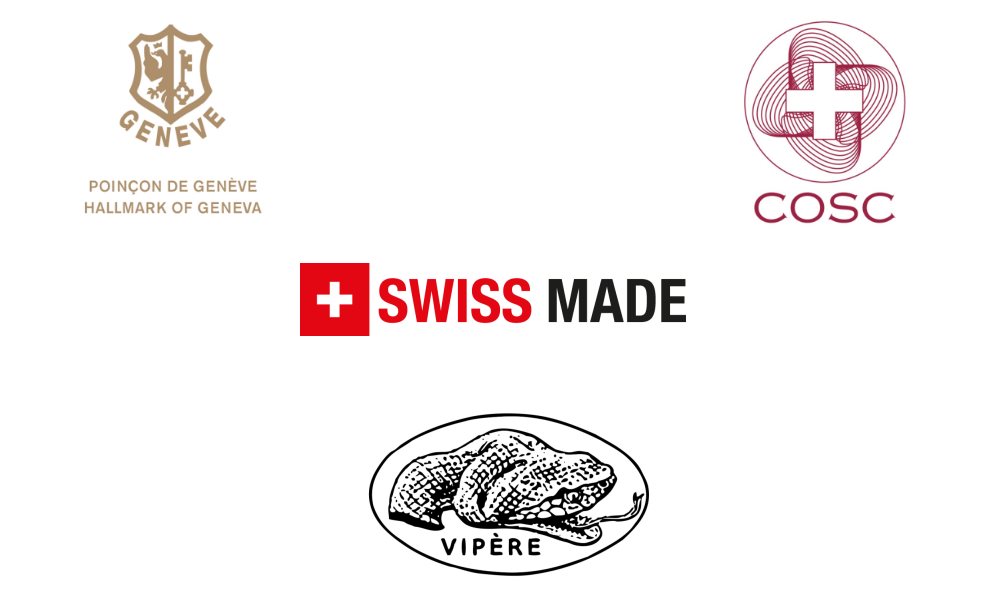The labels and certifications affecting watches and movements are essential for the watch industry. For lovers of timepieces, of course, sensitive to prestigious watch label coming to validate a high technical quality. But for manufacturers even more, both obtaining a label or a watch certification has become a pledge of expertise and authenticity to consolidate the reputation of a high-end production. We invite you to discover the various existing distinctions – notably Swiss.
The label shows: an essential quality reference
At the origin of every watch label and watch certification, there is the first of the Swiss distinctions: Swiss Made. This watch label, affixed to the dials of timepieces, was intended to certify the quality of the materials and know-how of the craftsmen-watchmakers at a time (the end of the 19th century) when counterfeits were more and more present.
The problem, then, was not recent. The question of origin has titillated consciences since the beginning of large-scale watchmaking: by the end of the eighteenth century, craftsmen who were smarter than others signed their mechanisms by the name of master watchmakers – that allowed them to ‘sell their production more quickly while reassuring buyers – and willingly lied at the manufacturing sites, preferring to name cities recognized for their watchmaking quality. But in developing, this system began to seriously threaten production – hence the officialization of the Swiss Made watch label to indicate a Swiss origin.
From there, the watch certification has become a guarantee of quality and controlled origin. Many territories have launched their own label shows, in Switzerland and elsewhere: the most famous are undoubtedly the Poinçon de Genève, established by the Geneva Watchmakers Society and the State Council in 1886; and the Viper Punch, created by the Observatoire de Besançon in 1897. This type of watch certification aims to protect local know-how, and to guarantee buyers the possession of a high quality product, truly manufactured on site.
Watch certification makes little ones
In fact, this need which has been felt since the beginnings of industrialization watchmaking has continued to strengthen with developments in the sector and the global market, pushing the field of watch certification to change with them. A good example is to look at what happened with the Swiss Made: this distinction, which was unchallenged, was attacked by the Swiss manufacturers themselves from the 80s, when manufactured parts in Asia at a lower cost began to infiltrate the cases of Swiss timepieces taking advantage of the shortcomings of the ordinance of 1971. Result: it was necessary to evolve and consolidate this label shows so that it retains its value .
In the process, other certifications were born – partly because of the distrust caused by doubts about the criteria defined by the Swiss Made, partly because the brands wanted to showcase their own production. In the commune of Val-de-Travers, four independent watch brands launched in 2004 a watch label issued by the Fleurier Quality Foundation, with the distinction that it distinguishes from completed models. For its part, the Geneva-based brand Patek Philippe has seceded to launch its own Punch – with its own control criteria. As for Jaeger-LeCoultre and Montblanc, they have developed internal processes to control their movements.
In addition, there are also professional tests conducted by independent workshops, such as the Chronofiable laboratory Dubois SA in La Chaux-de-Fonds, which is to practice advanced analysis of movements (under development or almost completed) in order to validate the choice of brands. The label shows issued by the FQF also requires to go through these tests.
Precision and reliability: chronometer certification
However, a label shows as demanding as it can not always guarantee the accuracy and reliability of a movement. For this, it is a different kind of watch certification: the chronometer label. This title is awarded by independent associations of brands, called “control offices”, and the best known is undoubtedly the COSC, or Swiss official chronometer control. The Observatoire de Besançon, which affixes the Viper Punch, is also authorized to submit a newsletter.
Chronometer certification is highly sought after by high-end manufacturers – Omega, Rolex, Breitling and others – who deposit all or part of their movements for extremely rigorous testing. These are intended to measure the offset between the movement and the reference time, up to half a second apart.
In conclusion, it should be noted that the notion of a watch label is inevitably evolutionary, because the standards in force at the time T, both in terms of technical quality and aesthetics, are brought to change and to no longer be accepted as such. by the marks. If the watch certification is a sesame still precious, acclaimed by manufacturers because it is a form of guarantee to present to the consumer (and because it allows to increase the selling price of a timepiece), the trend is towards the creation of exclusive brand-specific labels that guarantee their internal quality.


 Français
Français